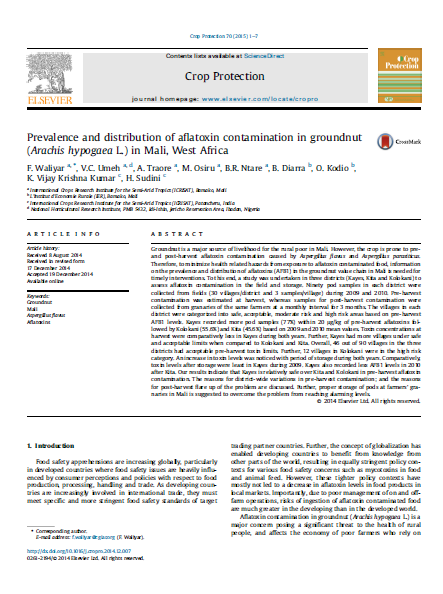Prevalence and distribution of aflatoxin contamination in groundnut (Arachis hypogaea L.) in Mali, West Africa
Summary
Groundnut is a major source of livelihood for the rural poor in Mali. However, the crop is prone to pre- and post-harvest aflatoxin contamination caused by Aspergillus flavus and Aspergillus parasiticus. Therefore, to minimize health related hazards from exposure to aflatoxin contaminated food, information on the prevalence and distribution of aflatoxins (AFB1) in the groundnut value chain in Mali is needed for timely interventions. To this end, a study was undertaken in three districts (Kayes, Kita, and Kolokani) to assess aflatoxin contamination in the field and storage. Ninety pod samples in each district were collected from fields (30 villages/district and 3 samples/village) during 2009 and 2010. Pre-harvest contamination was estimated at harvest, whereas samples for post-harvest contamination were collected from granaries of the same farmers at a monthly interval for 3 months. The villages in each district were categorized into safe, acceptable, moderate risk, and high risk areas based on pre-harvest AFB1 levels. Kayes recorded more pod samples (77%) within 20 μg/kg of pre-harvest aflatoxins followed by Kolokani (55.6%) and Kita (45.6%) based on 2009 and 2010 mean values. Toxin concentrations at harvest were comparatively less in Kayes during both years. Further, Kayes had more villages under safe and acceptable limits when compared to Kolokani and Kita. Overall, 46 out of 90 villages in the three districts had acceptable pre-harvest toxin limits. Further, 12 villages in Kolokani were in the high risk category. An increase in toxin levels was noticed with a period of storage during both years. Comparatively, toxin levels after storage were least in Kayes during 2009. Kayes also recorded less AFB1 levels in 2010 after Kita. Our results indicate that Kayes is relatively safe over Kita and Kolokani in pre-harvest aflatoxin contamination. The reasons for district-wide variations in pre-harvest contamination and the reasons for post-harvest flare-ups are discussed. Further, proper storage of pods at farmers’ granaries in Mali is suggested to prevent the problem from reaching alarming levels.
Open resource Download resource Access resource on external site

